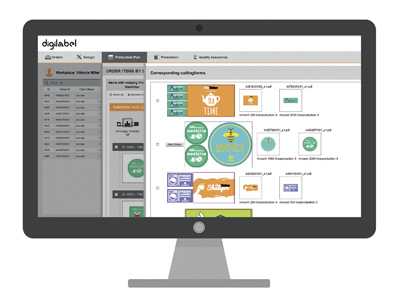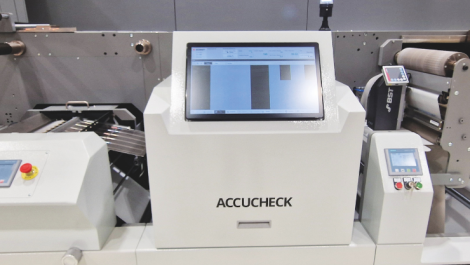DigiLabel allows multiple orders to be combined in one production run
Continued development in software for label production helps printers put more jobs through their factories as these become shorter and more varied. Neel Madsen looks at the latest announcements.
The less human interaction a label job meets during its journey from initial quote to final printed product, the better. With digital printing, the number of jobs coming through a business is vastly higher and you need a completely different business model to accommodate this growth. Software companies offer integrated and automated systems to ensure the highest productivity.
All shapes and sizes
German software manufacturer OneVision presented its DigiLabel 2-in-1 software solution for automated label production at the Xeikon Café last month. Launched last year, this promises to simplify complex workflows, combining artwork optimisation with label production planning.
As the software is able to process production data from various MIS, it can access pre-press tools and thus control the production workflow. Artwork can be imported, either directly or via third-party interfaces. The software then runs pre-flight checks and optimises the artwork as needed.
DigiLabel supports both pre-press and design processes by automating various necessary steps, explained sales manager Robert Lugg. He said, ‘For instance, if a customer sends a file containing comments, or the artwork format is too large, the ‘trim to die-cut’ function removes the superfluous parts of the artwork and is cropped to the die-cut, which helps avoid processing the artwork again in an external design systems.’ It also supports the automatic creation of standard die-cutting forms. Additionally, the software recognises die-cut colours, which are set up as spot or special colours, separate from CMYK. Other functions include creating white or varnish masks, and bleed generation, which further contributes towards the reduction of manual tasks.
For printers working with die-cutting machines, DigiLabel offers the option of cataloguing pre-used die-cut forms for use with incoming orders. A special algorithm recognises random shapes and matches them to die-cut forms from a library. For laser cutting, the cutter can be set up via barcodes from which the cutting contours and other laser parameters are generated automatically.
Mr Lugg said that fully automated multi-customer collect production run of labels is a unique selling point of the software. DigiLabel combines open orders and labels of varying shape, size and batch sizes to be printed on the same substrate into one collect run and transmits this to the press. He said, ‘This eliminates potential error sources in production, delivers time and material savings thanks to eliminating test print runs, whilst increasing throughput. After printing, the printed products are QA checked and if okay, released for shipping, or, reassigned to production planning for a new print run if any issues are found.’
Mr Lugs continued, ‘The capability of underlying a white mask for transparent substrates, or training the system with one click to recognise special colour names that have been defined as die-cuts, is new on the market. The automated generation of bleeds and multi-customer collect production runs are also features new to the industry.’
DigiLabel works as an intranet solution on standard web browsers and the user interface is based on a visual digital job docket. This allows orders to be forwarded and exchanged between departments and the various steps in the process of the job docket to be tracked.
Packing them in
Cloudflow from Hybrid Software is web-based and offered as an SaaS product that connects multiple workflows, devices and sites through a common interface and centralised database. Supported on Windows and Mac OSX, it interacts with external systems, such as file servers, MIS/ERP systems and web portals, and can submit files to workflows in several ways.
The Share function of Cloudflow means that files can be shared not only across devices, but across sites in different countries. Files are automatically synchronised but only the modified binary information is pushed to other sites.
Workflows employ a simple drag and drop methodology, which can be used to give customers access in a tailored fashion, allowing them to see only a limited number of files. PDF approval no longer needs a login and password, as security is embedded in the link emailed to the customer with the approval request.
Hybrid has recently introduced a new website for Packz, its native PDF editor for packaging and label workflows. With over 1200 installations worldwide, Packz runs on Mac and Windows platforms and provides 64-bit multi-processing and multi-threading facilities, eliminating the need for file conversions or proprietary file formats. All editing is done directly in the PDF; opened and saved without having to convert to other file formats or installing new fonts.

A new Packz website is now online
Recent developments include the Analyze and Fix functionality, which is essentially a pre-flight tool that the operator can use to check various design elements, such as compliance with FIR regulations, barcodes, fonts, colour and image quality. Trapping has been made automatic; the programme will indicate problem areas, which can then be corrected manually if preferred. There is now also a tabular step and repeat calculator, and a creator facility for producing continuous impositions.
The nested step and repeat feature for folding cartons can flip the structural data in order to generate a step and repeat for the reverse side of the carton.
New warping and 3D capabilities enable the user to check files for shrink sleeved bottles and folding cartons, etc, as a 3D object and make corrections in real time. Packz has a direct link with Creative Edge’s iC3D for real-time 3D simulation.
On the new website, a series of short videos demonstrate the different features within the software. Christopher Graf, managing director, said, ‘We wanted to build a site that provides a level of varied information which is accessible in an easy to use way that is not often encountered. The fully responsive site can be accessed from any mobile device such as an iPad or smartphone, with displayed information and images adapting automatically to the screen and platform being used.’
Visitors can also download free software, including the Packzview app for previewing and inspecting production PDF files.
Ready for use
Ahead of Labelexpo Europe, Esko has released details of two new turnkey solutions for label converters, which are based on existing tools. These pre-configured workflow solutions have been developed to address the many challenges that constrict throughput and cause inefficiencies in the label manufacturing process.
WebCenter Essentials is a project management bundle for label production available as an SaaS solution or deployed on site. The pre-configured set up promises onsite deployment, including go-live assistance, in less than a week. The software has a built-in graphical viewer coupled with approval tools for review and approval of 2D and 3D assets. It manages a database of centralised digital assets, with a search function and the ability to re-order existing labels. It comes with a dashboard and built-in operational reporting.
Automation Engine Essentials for Labels is turnkey workflow bundle for label pre-press workflow automation, which includes tools for preflighting, adding and checking barcodes and content, trapping, step and repeat, and adding marks and control strips.
The software can be upgraded with more functionality, such as automated quality control, colour management and output device control, which deliver higher throughput and can be plugged into the customer’s existing business system. Esko said that by Labelexpo in September, it will be running the application’s GUI in a browser to make it even easier and more intuitive for operators to launch jobs in pre-configured workflows.
‘With these turnkey workflows dedicated to label production, we make it really easy for label converters to deploy fully-featured automated workflows that come with unique functionality and connectivity no one else can offer today,’ commented Bernard Zwaenepoel, senior vice president software business.
The company is also working on bringing a colour preflight function to Automation Engine. This automated tool analyses the artwork and determines the best colour space and ink separations to print the job. Jan de Roeck, director solutions management, said, ‘How can you quote for a print job without knowing how many colours and inks are needed? This new function answers a lot of questions that label converters encounter early on in the process.’
Read the full March/April issue here.






